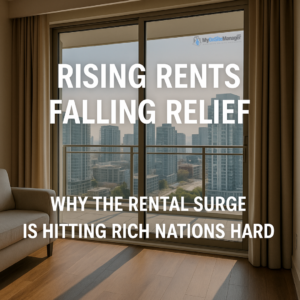For years, renters in advanced economies have grown accustomed to moderate rent increases typically around 2% per year. These were often manageable and rarely drew much public or policy attention. But today, that stability is gone. Across many wealthy nations, rents are now climbing at an annual pace of 5% or more, making it the steepest sustained surge in decades.
This spike isn’t just a financial burden; it’s reshaping the economy, widening inequality, and pushing millions into financial distress. While central banks focus on cooling inflation through higher interest rates, the stubborn rise in housing costs especially rents remains one of the biggest economic and social challenges of 2025.
The Numbers Behind the Surge
The scale of rental inflation is both striking and widespread:
-
France: Rent inflation has jumped from a modest 0.3% to 2.5%.
-
Australia: Rents are rising eight times faster than in the late 2010s.
-
Portugal: Seeing annual increases of around 7%.
-
New Zealand: House prices have dropped 15% from their pandemic peaks, but rents have surged by 14%.
-
United States: Median monthly rent payments jumped 10% in 2023 alone, with shelter costs making up nearly a third of core inflation.
In short, whether home prices are rising or falling, renters are paying more almost everywhere.
Why Are Rents Rising So Fast?
Several overlapping forces explain the current rental crisis:
1. Lagged Impact of Monetary Policy
When central banks raise interest rates, they slow down most consumer prices relatively quickly. But rents don’t adjust as fast because most leases renew annually or biannually. This means shelter inflation lags behind, staying “sticky” in official data even after other costs cool down.
In the U.S., for example, “owners’ equivalent rent” an estimate of what homeowners would pay if they rented their homes makes up about 25% of the Consumer Price Index. That weight ensures that high rents keep overall inflation elevated.
2. Housing Supply Shortages
Even before inflation surged, many countries were already underbuilding homes. Zoning restrictions, land scarcity, and high construction costs created a supply crunch that left renters with fewer options.
The Economist recently pointed out that in many rich countries, governments themselves are partly to blame, with restrictive housing policies that keep new developments from meeting demand. The result: too many people competing for too few homes.
3. Population Growth and Migration
In Australia, net migration has surged post-pandemic, adding strain to already tight rental markets. Similarly, U.S. cities that became popular during the pandemic like Austin, Nashville, and Pittsburgh have seen rents soar as demand outpaces supply.
4. Landlords Passing on Costs
Landlords facing higher mortgage rates, property taxes, and insurance premiums are passing those costs directly to tenants. Even in places where homeownership costs have eased, rent hikes have continued, driven by landlord leverage in undersupplied markets.
5. Inequality Between Owners and Renters
Homeowners especially those with fixed-rate mortgages or fully paid-off homes are largely insulated from these rising costs. Many even increased their discretionary spending by 25% between 2021–2023. Renters, by contrast, could only boost spending by 16%, despite facing higher housing costs.
This gap has widened the wealth and lifestyle divide between renters and owners, with renters increasingly left behind.
The Social Consequences
Rising rents aren’t just an economic issue they’re a social crisis.
-
Homelessness is climbing: Studies show a 20% increase in Canada and a 40% increase in the U.S. since 2018.
-
Financial stress is mounting: Renters are devoting larger shares of their paychecks to housing, leaving little for savings, healthcare, or education.
-
Generational divides are deepening: Younger adults, who are more likely to rent, are disproportionately burdened, while older homeowners remain protected.
In places like the UK, renters now spend an average of 34% of their income on rent, compared to just 19% for homeowners paying mortgages.
Case Studies Around the World
-
United Kingdom: Rents have jumped 21% between 2022 and 2025, outpacing mortgage payments. Housing affordability has become one of the most urgent political issues.
-
Australia: Facing its worst rental affordability crisis since the Global Financial Crisis, with analysts warning rents could rise another 18% by 2030 if supply issues persist.
-
United States: Pittsburgh has experienced a 48% rent increase since 2019, the steepest in the nation, fueled by pandemic-era relocations and limited new construction.
-
Portugal & Spain: Popular with digital nomads and tourists, their cities are experiencing rent inflation tied to short-term rental markets, further squeezing locals.
Policy Dilemmas
Governments and central banks face tough trade-offs:
-
Raise interest rates further? That may help cool demand but risks worsening affordability by pushing landlords’ borrowing costs higher.
-
Introduce rent controls? While popular with voters, strict caps can discourage new construction, worsening supply shortages in the long run.
-
Boost housing supply? The most sustainable fix, but politically and logistically complex, especially where zoning laws and local opposition block new builds.
Without decisive action, the imbalance between supply and demand will only grow worse.
The Bigger Picture
The rental crisis highlights three urgent realities:
-
Inflation will remain sticky as long as housing costs climb faster than wages.
-
Economic inequality will widen, with renters bearing disproportionate pain compared to homeowners.
-
Social instability could rise, as more households struggle to afford shelter something that should be a basic right.
Conclusion
The surge in rents across advanced economies is more than just a temporary spike it’s a systemic problem with deep economic and social consequences. Renters are caught in the middle of a perfect storm: lagging inflation metrics, supply shortages, population pressures, and widening inequality.
Unless policymakers take bold action to expand housing supply and rethink restrictive regulations, the affordability gap between renters and owners will only widen. And with rents rising at the fastest pace in decades, the time to act is now.
Source: Why rents are rising too fast, The Economist, March 16, 2025

